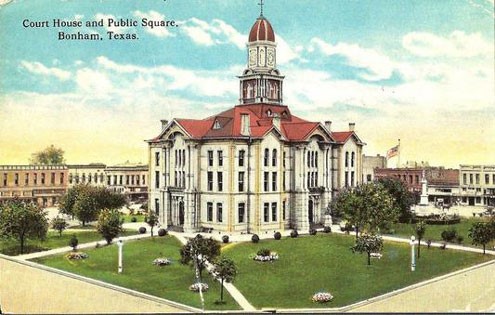
(ntxe-news.com)
From the time the first settlers arrived on the Blackland Prairie, they were full of pride to have found such a treasure. In the South, black clay is considered the best soil to plant cotton in. Throughout much of Hunt County, we are excited about such a wonderful farming region. That is, until the rain falls, and that clay becomes a quagmire. Then it’s a mess.
Predominately the Blackland goes deep into the earth. But up in Fannin County, there is a true surprise. The “Gober Chalk” south of Bonham has supplied a smooth, cream-colored limestone for the construction of churches, banks, mercantile stores, and other commercial buildings across northeast Texas. Rob Hodges submitted an article to the Texas Historical Commission, “Real Places Telling Real Stores”. Thank you, Rob Hodges and Susan Tietz, Architect and Coordinator of the Texas Historic Courthouse Preservation Program for sharing such an interesting story.
William Floyd and his wife Elizabeth Ford Floyd traveled in a covered wagon with their three children from Grassy Cove, Tennessee to Fannin County, arriving in January 1859. To show how tough the early settlers were, the mother carried her toddler son most of the way because he had wagon sickness.
Shortly after William arrived in Honey Grove, he visited three businessmen and borrowed money for a round-robin scheme to purchase the quarry of about 6,000 acres of limestone cropping south of town. Once out of the ground the limestone turned from a soft, mustard color to a hard and bright yellow. Several public buildings such as schools, city halls, and the Red River County Courthouse in Clarksville were coated the Floyd Quarry limestone.
William and his wife became successful. Some of the first items purchased was a suit for William and fabric for Elizabeth to make a dress for herself. They proudly wore the new frocks to join the local Methodist Church. When McKenzie Methodist Church in Honey Grove built its church in 1880, limestone from the Floyd Quarry was chosen to supply the outstanding limestone. William Floyd supervised installation. Unfortunately, one of the large masonry blocks fell, crushing Floyd’s leg that eventually caused his death in 1883.
Fast forward over a century to 2000. Red River County received a grant to restore its 1884 Second Empire courthouse from the Texas Historical Commission’s (THC) Texas Historical Courthouse Preservation Program that year. Some of the badly deteriorated limestone needed to be replaced. Even though all limestone may look alike, it is extremely difficult to match original masonry on a historic building unless stone from the original quarry is used.
The Floyd Quarry closed in 1904. When THC contacted Mary Pauline Yarborough, owner and descendant of the quarry, she graciously agreed to reopen it to find a perfect match for the Red River Courthouse. Twenty years later THC turned again to Yarborough and her quarry for restoration of the Fannin County Courthouse. Today restoration work is extensive but will hopefully be finished within 2021. Both will be treasures.
